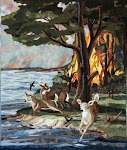When I speak of My Patterns, these are not sale items but are a collection of all the paperwork involved with my artwork carefully filed in one place. One element of my organization plan, which is rated very high on my list of necessary things-to-do, is the careful keeping track of and containing all the bits and pieces of each new project from the beginning sketches to its conclusion. My system is fairly easy and goes far towards keeping track of stuff especially in the middle of the designing debris and chaos. It is most helpful during those times when I am designing and working on more than one idea, doing what I call ‘leap-frogging’ from one project to another. Who does not work on more than one task? The brain becomes tired with concentrating on only one design challenge at a time.
Each artwork begins with rough sketches as I try to capture the essence of an idea. As I zero in on the plan and begin to expand the concept, I will pull out a crisp, new 9 x 12 clasp envelope to make ready for containing all the bits and pieces: sketches, procedural notes to myself, and anything having to do with the design at hand. As time marches forward, the envelope is labeled and filled so nothing is lost because of chaotic studio effort. If the project is extra large in size, a 2nd envelope is started for the master pattern and any related sections used to make templates.
When the title for the art is determined, it is written on the envelope, and eventually a listing of contents is added for quick future reference. Each envelope is placed in alphabetical order in a metal filing cabinet, where each creative endeavor can ‘talk’ to one another about their high-ho times in my studio. Yes, my imagination tells me, that the envelopes start whispering to one another after I close the drawer.
This filing cabinet is important because I am able to return to artworks done years ago, open an envelope to refresh my working memory of any project. What did I learn from it? I have also on occasion borrowed from past work to launch a new and different one. I call it piggybacking, which makes further use of a great deal of designing effort performed earlier. I do not always have to re-invent the wheel with every new creative tasking.
Sunday, March 28, 2010
Subscribe to:
Post Comments (Atom)




.jpg)



No comments:
Post a Comment